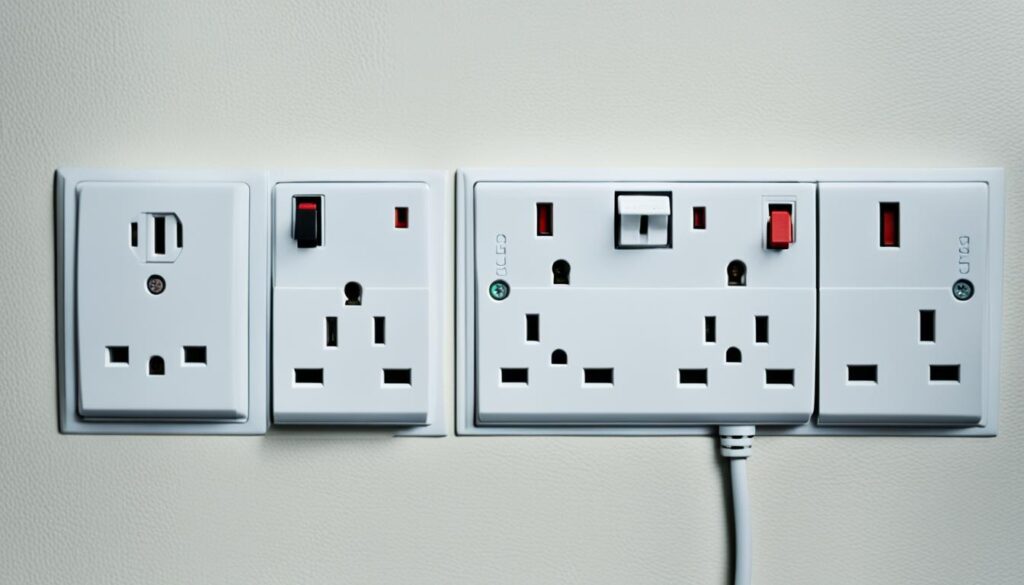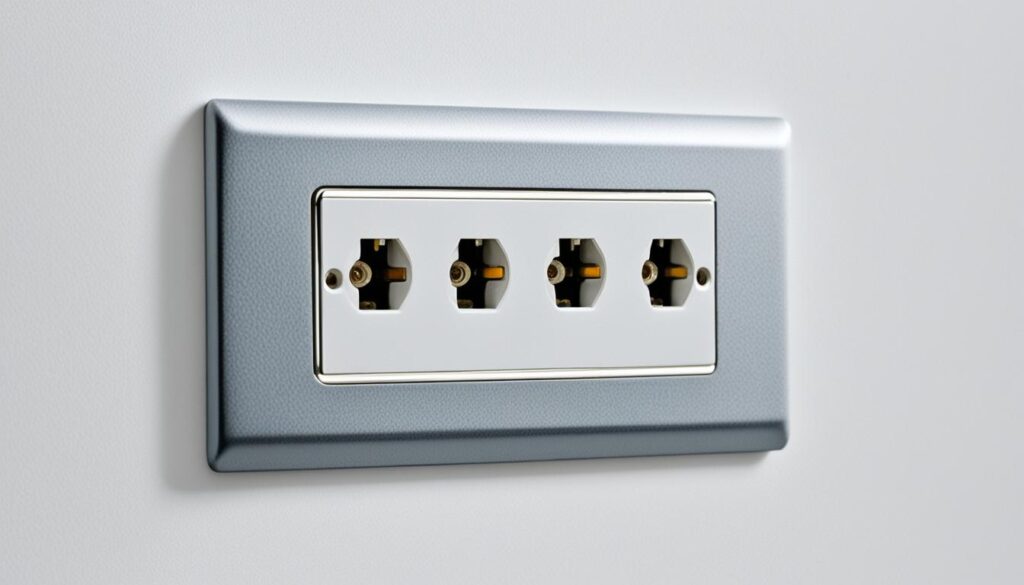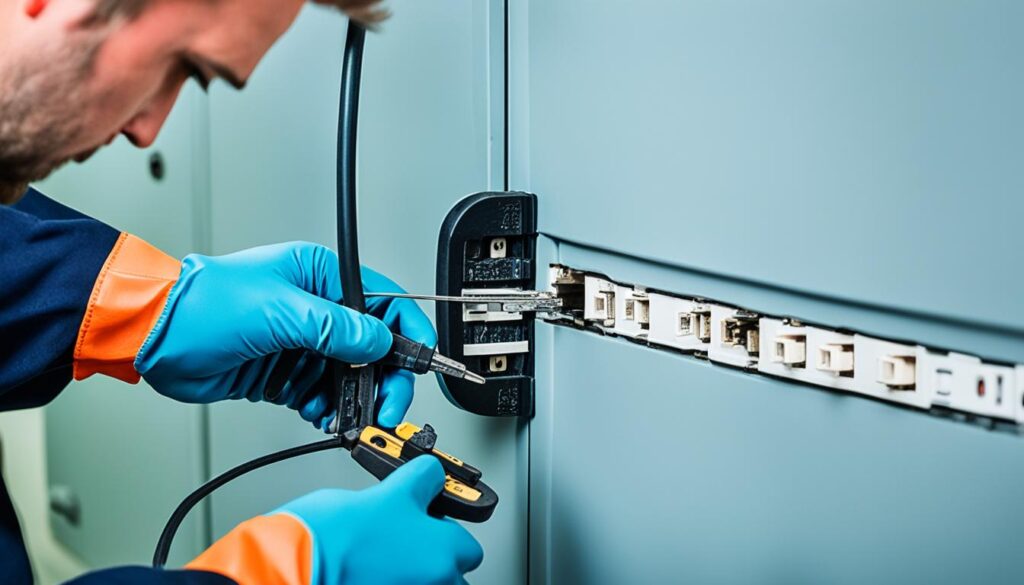In this expert guide, I will provide you with essential information about power sockets in the UK. Power sockets, also known as electrical outlets, plug sockets, or wall sockets, play a crucial role in delivering electricity to our homes, offices, and various electronic devices. Understanding the different types of power sockets, their features, and safety considerations is vital for efficient and safe electrical usage.
When it comes to power sockets, there are various terms used to describe them, including power points, socket outlets, electric outlets, receptacles, or power receptacles. All these terms refer to the same essential component that allows us to connect our devices to the electrical system.
Key Takeaways:
- Power sockets, also known as electrical outlets or plug sockets, are essential for connecting electronic devices to the electrical system in the UK.
- There are different types of power sockets with unique features and characteristics, including the number of pins, colors, and earth pin position.
- Identifying plugs and sockets based on amperage and voltage is crucial for compatibility and safety.
- When buying power sockets, consider the number of wall sockets needed, their color and finish, socket height, and compatibility with smart devices.
- Regularly checking the safety of plugs, including plug wires, casing, and fuse, is important for electrical safety.
Types of Plugs and Sockets Explained
Plugs and sockets play a crucial role in ensuring the proper transfer of electricity. Understanding the various types of plugs and sockets is essential for safe electrical usage.
Plugs and sockets come in different colors, indicating their voltage levels. For instance, yellow plugs are used for 110 volts, blue plugs for 230 volts (single phase), and red plugs for 400 volts (three phase).
The number of pins on a plug indicates the voltage and phase it supports. A plug with three pins is used for single phase connections, while plugs with four pins are for three-phase connections without an earth. In contrast, plugs with five pins are used for three-phase connections with an earth.
Identifying the correct plug and socket is crucial for a proper fit and ensuring safety. The earth pin’s position on a plug is indicated by the hands of a clock, providing a visual cue for proper alignment.
To determine the correct fit, plug and socket diameter measurements can be taken. This helps ensure that the plug fits into the socket securely without any loose connections.

Plugs and Sockets Types
| Plug Type | Socket Type | Pin Configuration |
|---|---|---|
| Type A | Socket A | 2 flat pins |
| Type B | Socket B | 2 flat pins and 1 grounding pin |
| Type C | Socket C | 2 round pins |
| Type D | Socket D | 3 round pins in a triangular configuration |
| Type G | Socket G | 3 rectangular pins |
| Type H | Socket H | 3 round pins in a linear configuration |
Available Plugs and Sockets
At Essential Supplies, we are proud to offer a diverse selection of plug and socket options to cater to various applications and power needs. Our range includes plugs and sockets with 3, 4, or 5 pins, providing flexibility and compatibility with different electrical systems. Whether you require a standard plug or a specialized socket, we have the solutions you need.
Our plug options are designed to meet different amperage requirements, ensuring optimal performance and safety. We stock plugs ranging from 16 Amps to 125 Amps, allowing you to choose the suitable plug for your specific power demands. Whether you need a plug for outdoor events, marine applications, or industrial power solutions, we have you covered.
Similarly, our socket options are carefully selected to offer versatility and reliability. With various socket pins available, our sockets accommodate different plug configurations, making them compatible with a wide range of electrical devices. We understand the importance of providing sockets that meet the diverse needs of our customers.
When selecting plugs and sockets, it is crucial to consider both the amperage and voltage requirements. Our products are available in different amperage and voltage ratings, ensuring compatibility with your electrical system. It is essential to choose plugs and sockets that match the specific amperage and voltage of your appliances to ensure safe and efficient electrical connections.
High-Quality Construction for Durability
At Essential Supplies, we prioritize durability and longevity in our plug and socket offerings. We understand that these electrical components play a critical role in everyday use and need to withstand regular wear and tear. That is why all our plugs and sockets are manufactured using high-quality materials that can endure rugged environments and frequent use.
With attention to detail and stringent quality checks, our plugs and sockets are engineered to deliver exceptional performance and reliability. You can trust our products to provide consistent electrical connections and withstand the demands of various applications.
When it comes to plug and socket options, trust Essential Supplies to provide you with the highest quality products that meet your specific needs. Explore our extensive range of options, including different pin configurations, amperage ratings, and voltage compatibility, to find the perfect fit for your electrical requirements.
| Plug and Socket Options | Amperage Range | Pin Configuration |
|---|---|---|
| Standard Plug | 16A – 125A | 3 pins |
| Specialized Plug | 16A – 125A | 4 pins |
| Specialized Plug | 16A – 125A | 5 pins |

Considerations When Buying Power Sockets
When it comes to purchasing power sockets, there are several important considerations that should not be overlooked. Each decision made during the buying process can have a significant impact on the functionality and aesthetics of your electrical setup. To help guide you in your selection, I’ve outlined key factors you must consider:
1. Number of Wall Sockets
The first step in buying power sockets is determining the number of sockets needed based on the room’s usage. Think about the appliances and devices that will require power and ensure you have enough sockets to accommodate them. As a general rule, it is recommended to have more sockets than anticipated to avoid relying on extension leads, which can be unsightly and potentially hazardous.
2. Color and Finish
While power sockets serve a purely functional purpose, they can also contribute to the overall aesthetics of your space. Consider the color and finish of the sockets to ensure they complement the room’s decor. Whether you opt for sleek white sockets for a minimalist look or prefer metallic finishes for a touch of elegance, choosing the right color and finish can add a polished touch to your electrical outlets.
3. Socket Height
It is essential to consider the height of the power sockets when making a purchase. Ideally, the height should be consistent with other sockets in the house to maintain a cohesive look. In the case of new builds or renovations, you will need to ensure the socket height meets building regulations to comply with safety standards. Taking these factors into account will ensure a seamless integration of the power sockets within your space.
4. Smart Compatibility
In the era of smart homes and automation, it is worth considering smart compatibility when buying power sockets. If you have existing smart devices or plan on implementing smart technology in the future, ensure that the sockets you choose are compatible with these systems. This will allow you to effortlessly control and monitor your electrical appliances and devices through a centralized smart home hub or smartphone app.
“A well-chosen power socket can not only enhance the functionality of your electrical setup but also contribute to the overall aesthetic appeal of your space.”
By carefully considering the number of wall sockets, color and finish, socket height, and smart compatibility, you can make informed decisions when buying power sockets. These considerations will help ensure that your electrical setup meets your needs in terms of functionality, safety, and visual appeal.
| Considerations When Buying Power Sockets |
|---|
| Number of Wall Sockets |
| Color and Finish |
| Socket Height |
| Smart Compatibility |
Checking the Safety of Plugs
Regularly checking the safety of plugs is crucial to ensure the proper functioning and electrical safety of your appliances. By conducting a simple inspection, you can identify potential issues and take corrective actions before they escalate.
Inspecting the Plug Wires
Start by examining the plug wires, making sure they are securely attached to both the appliance and the plug itself. Look for any cuts, nicks, or damages that could compromise the integrity of the wires. If you notice any issues, it is important to replace the plug or repair the wires promptly.
Examining the Plug Casing
Next, carefully inspect the plug casing for any cracks or signs of overheating. Cracks in the casing can expose the internal wiring, leading to potential electrical hazards. Signs of overheating, such as discoloration or melting, may indicate that the plug is overloaded or encountering excessive resistance, necessitating immediate attention.

Verifying British Standard Compliance
Ensure that the plug meets the standards set by the British Standard BS 1363. This standard guarantees the safety and reliability of plugs used in the United Kingdom. Additionally, check that the plug cable is firmly clamped within the plug and that no colored wires are showing, as this may indicate incorrect wiring or a potential safety risk.
Checking the Fuse
One of the critical components of a plug is the fuse. It serves as a protective device, preventing overloads and short circuits. Check that the fuse in the plug is the correct size for the appliance it is being used with, as specified in the manufacturer’s instructions. Using an incorrect fuse size can compromise safety and may result in electrical failures or potential hazards.
“Regularly checking plugs for any signs of damage or potential risks is essential to maintain electrical safety. By inspecting the plug wires, examining the plug casing, ensuring it complies with British standards, and verifying the fuse size, you can minimize the chances of accidents or electrical failures.”
By following these simple steps to check the safety of your plugs, you can ensure the reliable and safe operation of your electrical appliances and protect against potential hazards.
Understanding Fuse Ratings
Fuses play a crucial role in protecting electrical equipment from overload or faults. They act as safety devices that safeguard the lead and prevent any potential hazards. Understanding fuse ratings is essential to ensure the safety and proper functioning of your appliances.
When it comes to fuse ratings, they are determined based on the power rating of the appliance. This power rating is measured in watts and indicates the amount of electrical power consumed by the appliance when in use. It’s important to choose the appropriate fuse rating to match the power requirements of your appliances, as using an incorrect fuse rating can lead to equipment damage or even fire.
For appliances with a power rating of up to approximately 700 watts, a 3-amp fuse is recommended. This rating is suitable for devices like lamps, radios, or small kitchen appliances. On the other hand, appliances with power ratings between 700 and 3000 watts should be connected to a 13-amp fuse. This higher rating is suitable for larger appliances such as refrigerators, washing machines, or electric heaters.
Remember, it’s crucial to replace blown fuses with the same rating to maintain safety. Using a fuse with a higher rating than required can compromise the protection and lead to potential risks.
Now that you understand fuse ratings, you can make informed decisions when it comes to protecting your appliances and ensuring electrical safety in your home or workplace.

Fuse Ratings for Common Appliances
| Appliance | Power Rating (Watts) | Fuse Rating (Amp) |
|---|---|---|
| Lamp | 40 | 3 |
| Computer | 300 | 3 |
| Refrigerator | 200 | 13 |
| Electric Oven | 2000 | 13 |
Table: Fuse Ratings for Common Appliances
Conclusion
In conclusion, understanding the essentials of power sockets in the UK is vital for ensuring electrical safety in your home or business. By familiarizing yourself with different types of plugs and sockets, considering the number of wall sockets needed, regularly checking plug safety, and understanding fuse ratings, you can confidently use and install power sockets.
Identifying the right plug for your device and socket is key to preventing electrical hazards. Additionally, being mindful of the number of wall sockets required can help avoid the use of extension leads, reducing clutter and potential tripping hazards. Regularly inspecting plugs for damage or overheating is essential to prevent accidents.
Lastly, understanding fuse ratings and using the correct fuse size for your appliances is crucial for protecting your electrical circuits from overloads. Essential Supplies offers a wide range of high-quality plug and socket options to meet your specific electrical needs. Visit their website to explore their selection and ensure the safety and functionality of your electrical systems.

